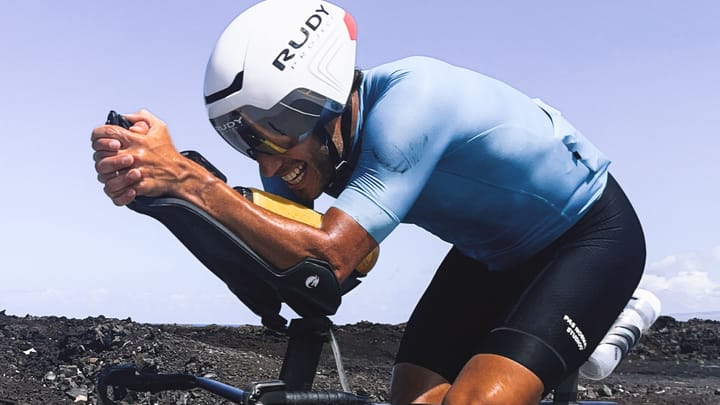The Importance of Using Lactate to Determine Exercise Intensity
Using lactate to prescribe exercise intensity can be a valuable tool for endurance athletes to regulate the intensity of their training sessions, particularly during long sessions.

If you’ve been partaking in endurance training for any length of time, you will know that regulating the intensity of training is one of the fundamental components of good preparation. Sometimes we want to perform training at a high intensity in order to drive up stress-related adaptive pathways (2), but, most of the time, we want to keep our intensity low, such that we can accumulate large overall training volumes and avoid becoming non-functionally overreached. As we have discussed before, as long-distance triathletes, we may want ~80% or more of our training week to occur at low physiological intensities below the lactate threshold (7).
To properly execute a specific training session objective – whether that be a low-stress, two-hour bike ride, or threshold run reps – we need to regulate our power outputs or speeds, such that we are physiologically in the right spot and achieving the desired result. Most commonly, athletes will do this using the tracking of external work rates; so, power outputs, running speeds, etc. Ideally, the intended power outputs and speeds will correspond to markers obtained in a physiological profiling assessment – our objectively-defined ‘thresholds’ – but they may also be derived from some kind of field test like an FTP test.
One of the potential pitfalls of using external work outputs (e.g. power output for cycling and pace for running), to regulate training intensity when doing a long training session is the potential for prolonged exercise to degrade the outputs you achieve at the thresholds; something we have termed athlete ‘durability’ (4). We all know that any given power output is tougher in the fourth hour of a long ride than in the first 20 minutes. Therefore, if, based on a well-rested lactate threshold estimate of 200 W, you were to set a target power output of 190 W for a long, low-intensity ride, you may risk inadvertently drifting upwards above your lactate threshold and generating excessive stress in say the third or fourth hour of the ride, if by then your lactate threshold power output has drifted down to 175 W.
To combat this effect, some athletes use internal intensity monitoring to regulate their outputs during long sessions, such as heart rate and blood lactate concentrations. Internal intensity monitoring has the advantage of being a direct measure of your physiology, which is ultimately what we are trying to regulate when we are concerned with managing stress. In this blog, I am going to outline some of the considerations I make when using internal intensity monitoring to regulate my training session outputs.
Heart rate monitoring
The classic method of internal intensity monitoring is through the measurement of heart rate. Athletes have been doing this for decades – longer than power meters and GPS watches have been around – and this method benefits from its convenience, relatively low cost (your strap should last for at least a couple of years!), and the clear indication of physiological stress that it provides; broadly speaking, the harder you work, the higher your heart rate will be.
Fixing low-intensity sessions to a heart rate value works well for athletes who have had the physiological profiling assessments I described above; in our lab, we will feedback the thresholds as power outputs or speeds, and the associated heart rate value. So, if your well-rested assessment of lactate threshold is estimated as 200 W and a heart rate of 150 beats.min-1, you might get around the troublesome downward drift in threshold power output by instead targeting a heart rate of 140-145 beats.min-1 during the session to ensure you remain at a low intensity. This approach does have a couple of assumptions; namely that your threshold heart rate remains constant over time during prolonged exercise, which may or may not be the case (we have some data on this that we are looking to publish soon, which seems to suggest that the heart rate associated with the threshold drifts up over time, even as the power output drifts down). What it does ensure, though, is that the physiological stress associated with your long ride or run doesn’t get out of control, which is good!
Blood lactate sampling
The other main internal intensity monitoring method that can – albeit cumbersomely – be used during training sessions is blood lactate sampling. Blood lactate sampling involves a fingerpick or earlobe with a lancet and analysing a tiny sample of capillary blood for its lactate concentration using a single-use strip and an automated analyser. Blood lactate is a useful marker of exercise intensity and is commonly used for determining physiological thresholds in laboratory tests. See our blog on interpreting blood lactate profiles using this link.

The use of blood lactate spot testing during training sessions has seen a lot of discussions online recently. This may be related to the articles (and success!) that have been published on the practices of successful Norwegian athletes. An athlete might do a low-intensity indoor cycling session, for example, and spot tests their blood lactate concentration every 30 minutes to ensure it has not exceeded a pre-specified value, like two mmol.L-1. Blood lactate concentrations increase when lactate is produced in muscle and enters the blood faster than it is being removed from the blood. So blood lactate concentrations will be elevated when we cross the lactate threshold and enter the so-called heavy or severe intensity domains. My understanding, through the available reading, is that: low-intensity training is set at ~0.3-0.8 mmol.L-1, tempo ~2-3 mmol.L-1, Threshold ~3-3.5 mmol.L-1. But, of course, the exact number varies depending on the individual athlete.
Now, whilst spot testing your blood lactate concentration may well provide useful insight into what is going on physiologically, and the internal metabolic stress you are under, its use is limited in a number of ways. Firstly, the cost adds up; the analysers go for more than heart rate monitors do, but the real cost is in the single-use strips, lancets, and other consumables involved in the measurement. In New Zealand, we pay ~$800 NZD for a carton of 250 strips, so taking just ten samples per week would cost more than $30 NZD just in strips. YIKES!
It can also be quite difficult to take these measurements on yourself. Granted, once you know what you are doing, it is relatively straightforward to take a blood sample from your own finger whilst on an indoor trainer. However, maintaining the same intensity you had been riding at can still be tricky. If you have to get out of position and faff around for 30 seconds while taking the measurement, it is possible you will very transiently push your blood lactate concentration up simply as a result of taking the measurement, because your pedalling efficiency has worsened.
Another important factor is the individualization of lactate numbers associated at differing intensities. These need to be established in a lab to use lactate for intensity demarcation. For example, a blood lactate concentration of 4 mmol.L-1may occur at the anaerobic threshold for athlete A, but may be well above threshold and therefore much more demanding for athlete B. In my experience, the higher the athlete's level, the lower the lactate value at threshold (VT2 at 2.5-3.5 mmol.L-1). On that, lactate levels are also considerably impacted by habitual diet. And as such, low-carb athletes should expect lower lactate levels at given relative intensities.
I also don’t see spot lactate sampling as a replacement for heart rate monitoring, primarily because heart rate monitoring gives you a continuous measurement, every moment of your session. You can spot your heart rate rising and immediately drop your effort if that is the goal of your session. With blood lactate sampling, you are limited to data points that are only as frequent as you take them. So, whilst in some instances, blood lactate sampling may be a useful addition to heart rate monitoring, I personally would never swap out my heart rate monitor in favour of serial measures of blood lactate concentration.
The 70.3 World Champion, Gustav Iden says “today we’re using heart rate, although it’s not that scientific”. I thought this was interesting, old school “yes”, but I personally don’t think this is any less “scientific” than a lactate sample.
The last point is a nuanced but important one. Regardless of how experienced you are, your blood lactate concentration measurements will have a technical analytical error of possibly around ~0.4 mmol.L-1 (1). So, if you measure a concentration of 2.2 mmol.L-1 and therefore decide to drop your speed to keep your stress down, the true concentration could easily in fact be 1.8 mmol.L-1, which might have given you a different inference. Similarly, as the measurements are concentrations in blood, they will also change as fluid balance shifts during exercise. If your plasma volume – the fluid component of blood – decreases by 10% during a training session, your measured blood lactate concentrations will increase, even if the total amount of circulating lactate is actually the same. This becomes a real problem during longer sessions, particularly in the heat. The points above are why we like to model curves with many data points, and even take multiple measurements at a single time point when working in the lab. So, whilst spot testing for lactate can give useful insight into the internal stress generated by exercise, we must be a little cautious not to overinterpret the number that flashes up on the analyser.
Anything else?
Validating and/or developing new techniques that can be used to monitor internal intensity during training sessions is something of great interest to my research colleagues here in Auckland and me. A range of promising alternatives are being investigated and may eventually emerge as useful tools for athletes in the field; these include wireless measurement of muscle oxygenation (3) and ventilatory measurements (5). If you’re someone who really like to keep it simple, a good old ‘talk test’ to help athletes; if you can easily hold a conversation during exercise, you are probably below the lactate threshold, if you can’t you probably aren’t (6).
Recommendations
So, what are my main recommendations for endurance athletes looking to regulate intensity during training sessions:
- If you can, get into an exercise physiology laboratory and get your thresholds and zones estimated by an expert
- Monitor external work rate and internal intensity during all training sessions
- Get a good chest-strap heart rate monitor, and use it
- If you really want to, supplement your heart rate data with spot testing for blood lactate concentrations; but acknowledge the limitations that these measurements have
- Low-intensity training sessions should be ‘conversational’; if you can’t easily hold a conversation, you’re probably not at a low physiological intensity!





Comments ()